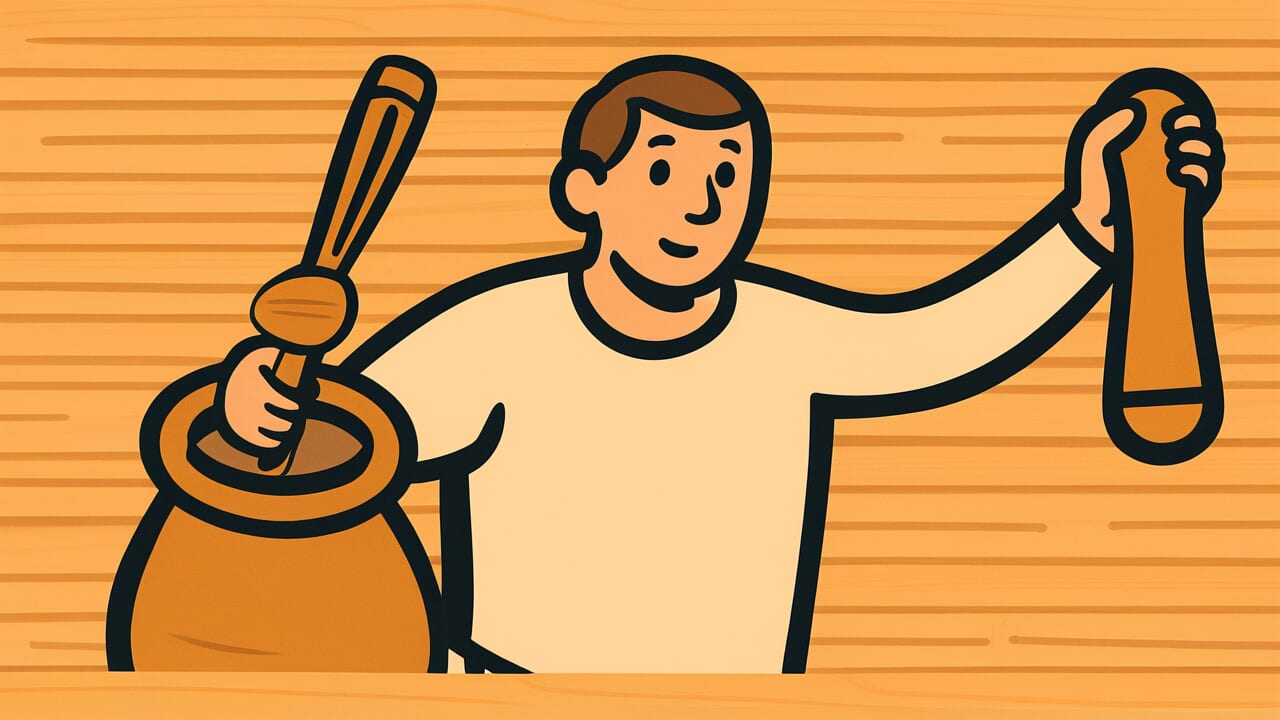How to Read “Hit with a pestle, hit with a ladle”
kine de atari shakushi de ataru
Meaning of “Hit with a pestle, hit with a ladle”
“Hit with a pestle, hit with a ladle” describes a situation where you get attacked no matter which direction you run. There’s simply no escape.
Whether you’re struck by a heavy pestle or a light ladle, you end up hurt either way. This proverb means you can’t avoid difficulty no matter what you do.
This saying applies when you seem to have multiple choices, but all of them lead to bad outcomes.
For example, imagine your boss and senior colleague give you conflicting instructions. You’ll get scolded no matter which one you follow.
Or picture yourself trapped in a dead-end situation where every path leads to problems.
Even today, everyone experiences moments when they’re caught in the middle and can’t move. This proverb uses familiar kitchen tools to express that inescapable difficult position.
By comparing it to everyday objects, the saying makes this frustrating experience easy to relate to.
Origin and Etymology
No clear written records explain the origin of this proverb. However, we can make interesting observations from the words themselves.
Notice how the proverb pairs two traditional Japanese kitchen tools: the pestle and the ladle.
A pestle is a heavy, hard wooden stick used for pounding mochi rice cakes. A ladle is a flat wooden spoon for scooping rice or porridge.
These two tools differ completely in shape, weight, and purpose. Yet they share something important.
Both are wielded by hand and involve the action of hitting or striking something.
The word “ataru” means to receive a blow or strike. This proverb likely originated from expressions used during kitchen work.
Whether you’re hit with a heavy pestle or a light ladle, you end up hurt. The proverb captures this reality.
What’s interesting is that different tools produce the same result. This reflects everyday experiences where you can’t escape difficulty no matter how you try.
By using tools from the kitchen, the heart of daily life, the saying became a metaphor everyone could understand. It’s folk wisdom expressed through familiar objects.
Usage Examples
- When I propose new ideas, they get rejected. When I do nothing, I get yelled at. It’s truly “hit with a pestle, hit with a ladle.”
- With my parents divorcing, the child suffers whether they go with their father or mother. I worry about that “hit with a pestle, hit with a ladle” position.
Universal Wisdom
“Hit with a pestle, hit with a ladle” has been passed down through generations because it addresses a universal human struggle: the dilemma of choice.
Throughout life, we often face situations where no choice leads to a good outcome. We get trapped with nowhere to turn.
Why do such situations arise? Because human society operates through complex webs of conflicting interests.
When you try to meet one person’s expectations, you disappoint someone else. As long as you live within organizations, being caught in the middle is unavoidable.
What’s interesting is that this proverb doesn’t just lament having no escape. It gives you a perspective to recognize your situation objectively.
By putting it into words as “hit with a pestle, hit with a ladle,” you can calmly observe the unreasonable position you’re in.
Our ancestors knew that inescapable difficulties exist in life. That’s why they created this proverb.
They wanted people in similar predicaments to feel “I’m not alone.” Naming the experience makes an unreasonable situation slightly more bearable.
That’s human wisdom at work.
When AI Hears This
When you examine the situation of being hit whether by pestle or ladle through probability theory, interesting facts emerge.
Humans tend to think, “I’ve failed twice already, so I must succeed next time.” This is a complete illusion.
Even if you roll a die and get 1 three times in a row, the probability of getting 1 on the fourth roll remains one in six. Past results don’t influence the future.
This is called independent events.
However, the situation this proverb describes shows an even harsher reality. Being hit by both pestle and ladle means changing tools doesn’t change the outcome.
Even the hope that “changing methods will improve success rates” gets betrayed.
In probability theory, when multiple independent trials all fail, you multiply individual failure probabilities together.
For example, if an action has a 50 percent failure rate, repeating it three times gives only a 12.5 percent chance of failing every time.
But when the human brain sees consecutive failures, it starts suspecting, “This isn’t coincidence. There must be a structural problem.”
This intuition is often correct. If you’re hit by both pestle and ladle, the problem likely isn’t the tools.
The issue lies in what’s being struck or how the striking happens. Probability theory teaches us the importance of distinguishing truly random failures from systematic ones.
Lessons for Today
This proverb teaches modern people an important lesson: “When trapped with no escape, you need to change the situation itself, not multiply your choices.”
When we face difficulties, we try to find answers within the choice between A or B.
But if both choices lead to disadvantageous results, maybe the two-option question itself is wrong.
When you’re in a “hit with a pestle, hit with a ladle” situation, what you really need isn’t choosing between pestle or ladle. You need to move to a place where you won’t get hit at all.
In modern society, situations where you’re caught in the middle keep increasing.
However, knowing this proverb helps you realize, “This isn’t a choice problem. It’s a structural problem.”
If you’re caught between your boss and senior colleague, consult a third party. If all options are unfavorable, create a new option yourself.
This shift in thinking is the true wisdom this proverb suggests.
Don’t just lament difficult situations. Try viewing the problem from a higher perspective.



Comments